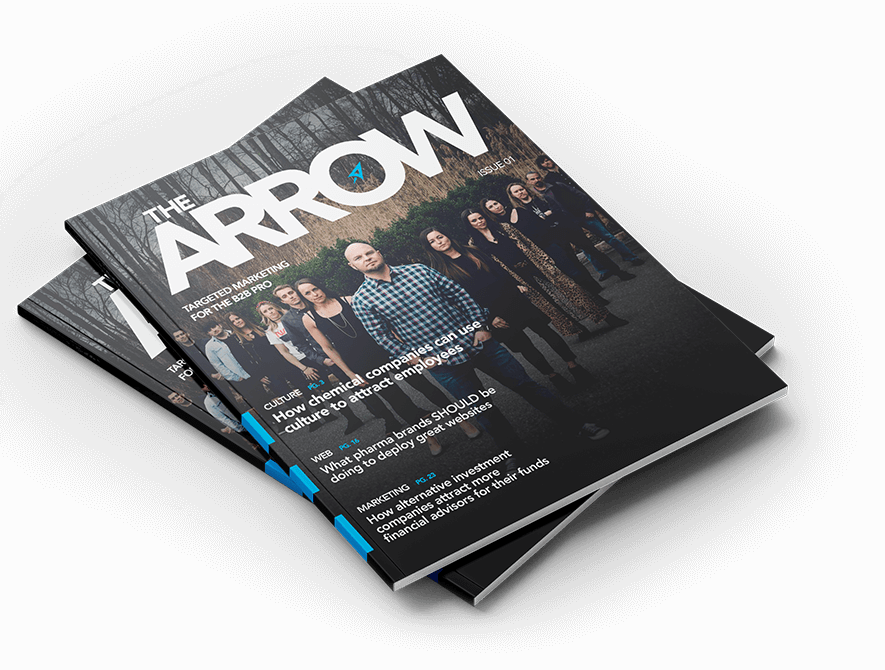How Much Should You Invest on Marketing in 2024
Chris Mulvaney is the CEO of CMDS. I make things... I’m the creative entrepreneur with passion for (re)making brands and inventing solutions to problems no one knows exist.
Answer: Most invested 9.1% in 2023. On average, 5% to 15%!
But it’s climbing…
Many companies are asking “How Much Should I Invest on Marketing in 2024?” We’re unlocking the secrets of effective marketing spend with our comprehensive guide. Learn to align goals, understand your audience, and leverage key strategies to determine the right digital marketing budget for your business.
In this article you’ll find:
- The foundational elements of digital marketing strategy, including goal alignment, audience analysis, and competitor benchmarking
- An explanation of the significance of diversifying digital marketing efforts across various channels to reach a broader audience and maximize impact
- Key performance indicators (KPIs) and how to measure ROI, enabling you to make informed budget adjustments and optimize campaign effectiveness
- Industry benchmarks for digital marketing budget allocation
- Practical tips on resource allocation across channels based on business type, industry, and target audience
We’ve broken this article down into the following sections:
- Understanding the Digital Marketing Landscape
- Budgeting Benchmarks for 2024
- Changes in Retail Media Spending
- Variations in Marketing Budget by Industry
- Where Marketers Are Investing in 2024
- Top Business Challenges for Marketers
- Navigating Social Media for Business Growth
- How Uncertainty Impacts Marketing Investments
- Emerging Trends in 2024
- Strong Agency Partnerships Lead to Marketing Success
- Key Takeaways
Understanding the Digital Marketing Landscape
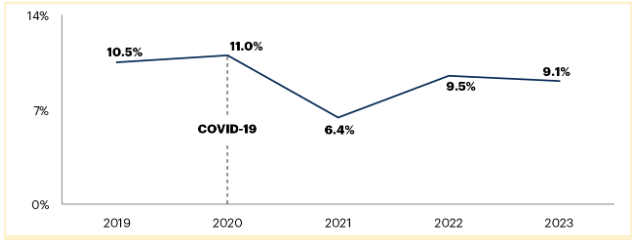
Digital marketing encompasses a broad range of strategies and channels, including search engine optimization (SEO), social media marketing, content marketing, email marketing, pay-per-click (PPC) advertising, and more. Each of these channels serves a unique purpose, and the effectiveness of a digital marketing strategy depends on the specific goals and target audience of a business.
In the present digital marketing landscape, mobile optimization reigns supreme as users increasingly engage through mobile devices. Social media platforms continue to shape consumer interactions, making them vital channels for brand visibility and engagement.
Short-form video content has surged in popularity, driving marketers to embrace platforms like TikTok and Instagram Reels to connect with audiences effectively. The landscape is marked by a focus on user-generated content (UGC) and community engagement, emphasizing the significance of authenticity and building relationships.
Navigating the dynamic environment also involves adapting strategies to comply with evolving privacy regulations, ensuring businesses maintain relevance and effectiveness in an ever-evolving digital space.
2024 Budget Benchmarks: How Much Should I Invest in Digital Marketing in 2024?
Marketers are being pressured to do more with less, but what does that really mean? According to a survey of North American CMOs conducted by the research firm Gartner, marketing budgets composed 9.1% of total company revenue in 2023, a slight dip from the 9.5% reported in 2022.
At the same time, 86% of marketers surveyed by Gartner said they are planning to make “significant changes” to how the marketing function works within their organizations in 2024 in order to achieve more sustainable results in the coming year.
Determining the exact budget allocation for digital marketing can vary based on several factors, including the organization’s industry, business goals, target audience, and overall marketing strategy. On average, businesses allocate between 5% and 15% of their total revenue to marketing efforts, however this can fluctuate based on the industry. For example, industries with high competition or those undergoing digital transformation may lean toward the higher end of this spectrum. If a business is in a growth phase, it might allocate a higher percentage to digital marketing to fuel expansion. Conversely, a business focused on maintaining its market share may have a more conservative budget.
Changes in Retail Media Spending
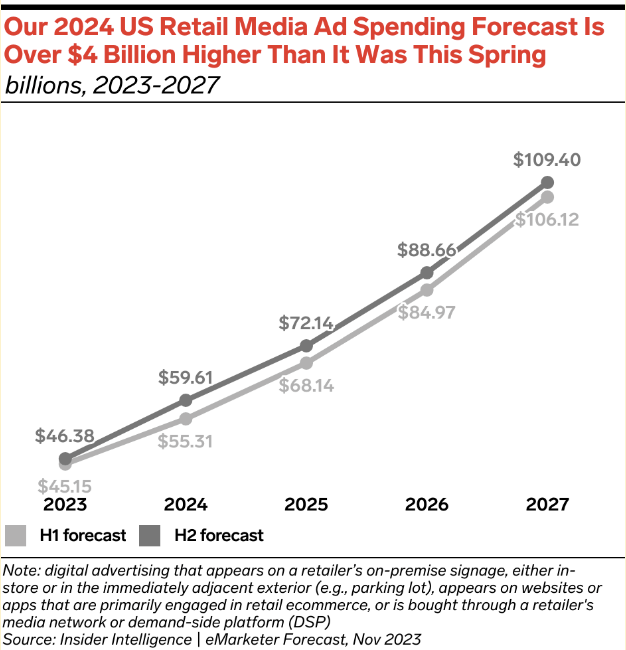
This chart from eMarketer shows that U.S. retail media ad spend in 2024 will be even higher than initially projected.
For the past several years, retail media spending has been on the rise. Now, with the expansion of connected TV and other off-site formats, marketers appear to have reached a tipping point.
According to forecasts by eMarketer, U.S. retail media ad spending will hit $59.61 billion in 2024. Rather than just demonstrating that retail media is here to stay, this data shows that retail media is here to expand.
Variations in Marketing Budgets by Industry
Marketing budgets vary significantly across different industries. For example, SaaS companies typically invest more heavily in marketing, often exceeding 20% of revenue, while traditional industries like manufacturing may allocate closer to 5%.
While there is no one-size-fits-all approach, understanding the general trends in marketing budget allocation within various industries can provide insights for businesses looking to benchmark their own strategies.
Here’s a brief overview of how marketing budgets may vary across different sectors:
Consumer Goods & Retail
- High competition often leads to substantial marketing budgets.
- Emphasis on both digital and traditional marketing channels.
- Significant investments in seasonal campaigns, promotions, and loyalty programs.
Technology & Software
- Heavy reliance on digital marketing, especially content marketing and online advertising.
- Emphasis on thought leadership and educational content.
- Substantial budgets for product launches and ongoing brand building.
Healthcare & Pharmaceuticals
- Focus on educational content and building trust.
- Regulatory constraints may impact the types of marketing channels used.
- Considerable budget allocation for research-backed content and community engagement.
Finance & Banking
- Strong emphasis on building trust and credibility.
- Investments in digital marketing for online banking services.
- Compliance and regulatory considerations influence marketing strategies.
Automotive
- Significant budget allocation for traditional advertising, especially during product launches.
- Growing emphasis on digital channels, including social media and online promotions.
- Partnerships and sponsorships play a crucial role.
Travel & Hospitality
- Heavy reliance on digital marketing for online bookings and promotions.
- Influencer partnerships and user-generated content are common strategies.
- Seasonal campaigns and special promotions are prevalent.
Real Estate
- Focus on local marketing and community engagement.
- Digital channels used for property listings and virtual tours.
- Relationship-building through events and partnerships.
B2B Services
- Emphasis on thought leadership, content marketing, and B2B networking.
- Account-based marketing (ABM) strategies are common.
- Digital channels such as LinkedIn and industry conferences play a crucial role.
Food & Beverage
- Significant investment in social media marketing and influencer partnerships.
- Seasonal promotions, partnerships with chefs, and unique campaigns are common.
- Strong focus on visual content for product promotion.
Education
- Digital marketing for student recruitment and online course promotion.
- Content marketing for thought leadership and educational resources.
- Open houses, webinars, and community engagement play a role.
It’s important to note that these are general trends predicted for 2024, and individual companies within each industry may allocate their budgets differently based on specific goals, market positioning, and other unique factors. Additionally, the rapid evolution of digital marketing has led to increased flexibility and adaptability in budget allocation strategies across various sectors. Regular analysis, testing, and optimization are key components of successful marketing budget management, regardless of industry.
Where Competitors Are Investing in 2024
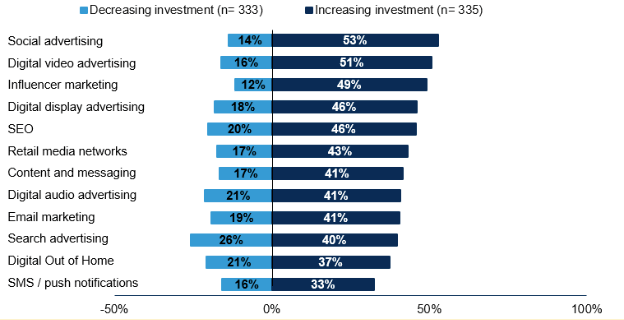
Social advertising is still on the rise, as marketers cited it as the top digital channel for increasing investments in the coming year. Fifty-three percent of marketers expect to increase their investment in social advertising, while just 14% will decrease their budget. Social advertising was followed by digital video advertising and influencer marketing.
Marketers are increasing investments in social advertising, digital video advertising, and influencer marketing due to the prevalence of consumers on social media platforms, the popularity of visual content, and the effectiveness of these strategies in reaching target audiences.
The rise in digital video consumption, coupled with the authenticity and targeted reach offered by influencer marketing, contributes to the appeal of these channels. Advanced targeting options, measurable ROI, and the adaptability to ad blockers further enhance the attractiveness of these marketing avenues, allowing brands to engage audiences effectively and achieve global visibility.
Top Business Challenges for Marketers in 2024
According to a Gartner report, the No. 1 business challenge for marketers in 2024 is expected to be finding new customers (35%), followed by upskilling employees (32%) and hitting marketing goals (29%).
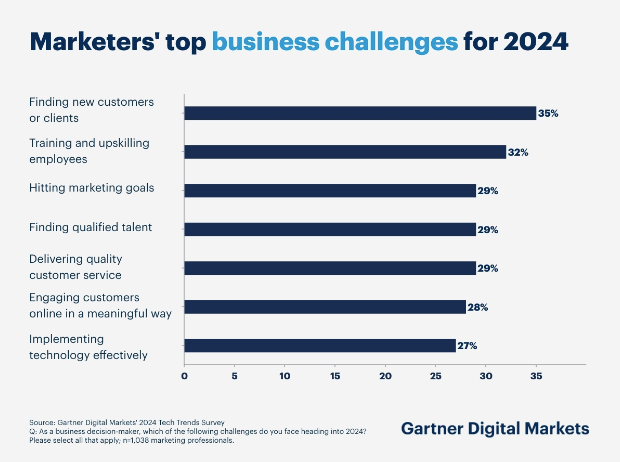
Finding new customers or clients remains a perennial challenge for marketers, and several factors are expected to contribute to the complexity of this task in 2024.
In many industries, market saturation is a prevalent issue, with numerous competitors vying for attention in a crowded marketplace. Additionally, shifting consumer behavior, influenced by evolving technologies and societal trends, requires constant adaptation by marketers to effectively target and acquire new customers.
The influx of new businesses into the market is intensifying competition, as well, making it harder for marketers to differentiate their offerings and capture the attention of potential customers.
Rapid advancements in technology present both opportunities and challenges, requiring marketers to stay ahead of the curve and utilize emerging tools and platforms like artificial intelligence (AI) effectively.
The dynamic landscape of marketing channels, rising customer acquisition costs, and the need to build and maintain customer loyalty are further compounding the difficulties in this area. Data privacy concerns, influenced by regulations like GDPR, have also altered the way marketers collect and use customer data in recent years, adding another layer of complexity.
Navigating Social Media for Business Growth
Social media can be an influential channel for stoking interest and driving consumer behaviors. For example, according to an April 2023 survey by Deloitte, more than half of consumers say they often watch a TV show or movie on a streaming video service after hearing about it on social media.
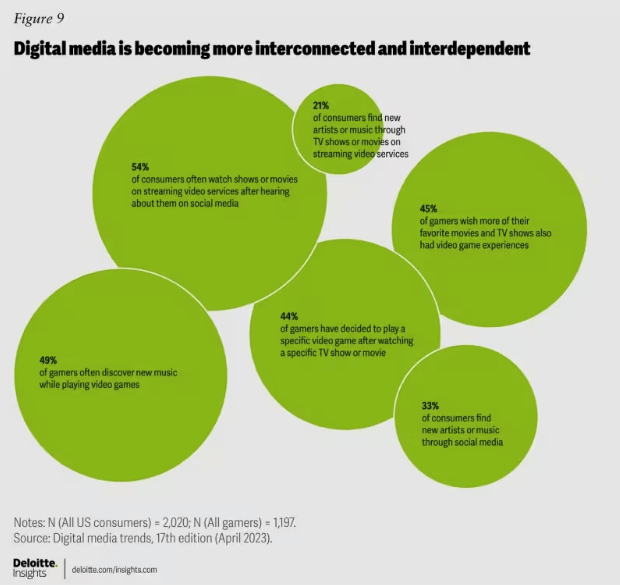
A strategic presence on social platforms not only helps in building brand awareness but also fosters meaningful engagement with the target audience. As businesses navigate through the myriad options available, certain social media channels stand out for promising optimal returns on investment in 2024.
Instagram continues to dominate the visual-centric social media space, making it an ideal platform for businesses with visually appealing products or services. The introduction of Reels has further enriched the content possibilities, providing businesses with creative avenues to connect with their audience. The platform’s emphasis on aesthetics and storytelling makes it particularly effective for lifestyle brands, e-commerce ventures, and businesses targeting a younger demographic.
For businesses in the B2B realm, LinkedIn remains an indispensable platform. The platform’s professional environment makes it ideal for showcasing industry expertise, thought leadership, and establishing valuable connections. Businesses can humanize their brands and engage with their audiences in real-time, fostering a sense of trust and authenticity.
TikTok
TikTok’s incredible rise in popularity among Gen Z users has turned it into a powerhouse for businesses aiming to connect with this demographic. Short-form, entertaining content is the name of the game on TikTok, making it an excellent platform for brands willing to embrace creativity and humor. With the ability to go viral quickly, TikTok offers businesses a unique opportunity to tap into the zeitgeist and build brand recognition among younger audiences.
Upping Investments in 2024, Despite Economic Uncertainties
Businesses gaining market share are increasing spending on digital marketing, even in uncertain times. According to McKinsey, almost all sales and marketing decision makers are currently concerned about economic conditions. However, market share “winners” — defined as businesses reporting a 10% greater increase in market share from 2021 to 2022 — think differently about how they sell, which channels they sell through, and how they plan to implement their strategy across the full ecosystem of channels. Seventy percent of “winners” say they plan to increase their investment in digital marketing, while fewer than than 40% of “laggards” plan to increase their share.
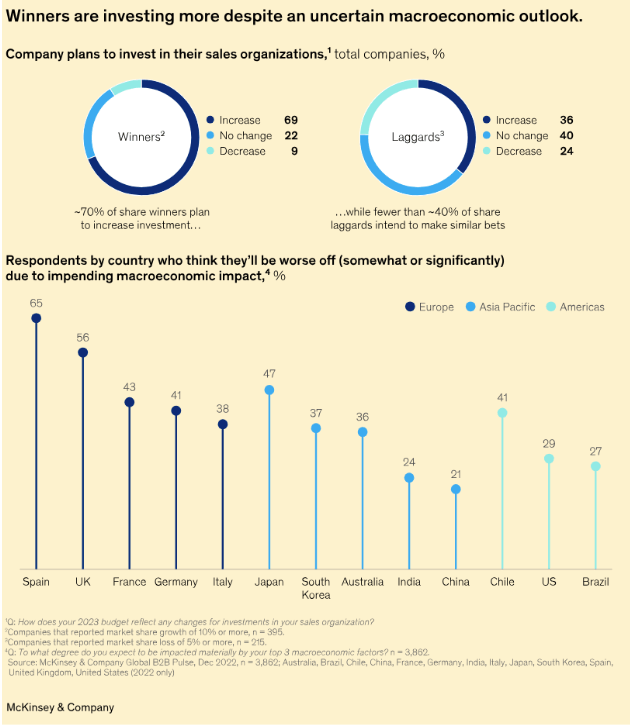
Emerging Trends in Marketing Budgets
Shifting Digital Landscape
With the rise of AI, automation, and the metaverse, businesses are increasingly shifting their budgets towards digital marketing channels. This trend is expected to continue into 2024, with social media, search engine marketing, and content marketing remaining top priorities.
Focus on Data & Measurement
The growing importance of data-driven marketing is influencing budget allocations. Businesses are investing in analytics tools and platforms to track performance, measure ROI, and optimize their marketing campaigns for better results.
Personalization & Customer Experience
In 2024, we can expect to see businesses prioritize personalized marketing campaigns that deliver a seamless and relevant customer experience. This may involve allocating resources to customer relationship management (CRM) systems and personalization technologies.
Hybrid Models
Many businesses are opting for hybrid marketing models, combining traditional and digital channels for maximum impact. This approach allows them to leverage the strengths of each channel and reach a wider audience.
Strong Agency Partnerships Lead to Success
Partnering with a digital marketing agency can be a strategic move that propels businesses and brands toward success in the digital landscape. Agencies like CMDS bring a wealth of expertise and experience to the table, navigating the complexities of online marketing with finesse.
By leveraging an agency’s specialized skills, businesses are able to access a diverse set of professionals proficient in areas such as SEO, social media management, content creation, and data analytics. This collaborative approach allows for a holistic and integrated digital strategy, ensuring that each facet of the online presence complements the others. The scalability of agency partnerships is a notable advantage, as they can adapt strategies to match the evolving needs of each business.
At CMDS, we bring an external perspective, offering fresh insights and creative solutions to marketing challenges. As your strategic ally, we’ll not only enhance your online visibility, but also work together to optimize your digital marketing budgets for maximum impact and sustained growth.
Key Takeaways
Savvy businesses must adopt a strategic and flexible approach to budgeting to remain competitive in 2024. By aligning marketing goals with overall business objectives, understanding target audiences, and staying abreast of the latest industry trends, companies can make informed decisions regarding their digital marketing budgets in 2024.
While there is no one-size-fits-all solution, businesses can employ a combination of methods to determine an appropriate budget. Continuous monitoring of key performance indicators and a commitment to testing and optimization are vital for maximizing the return on investment and ensuring long-term success.



